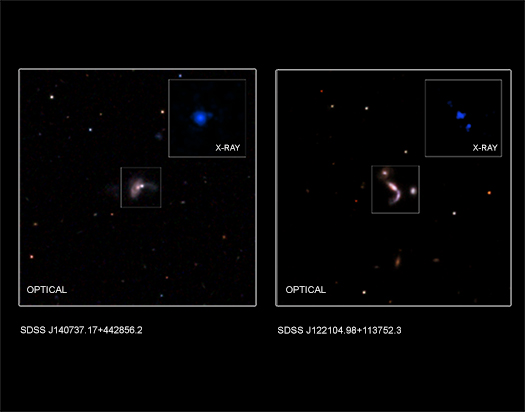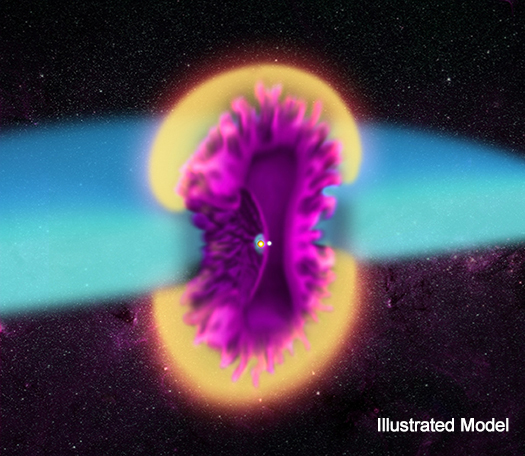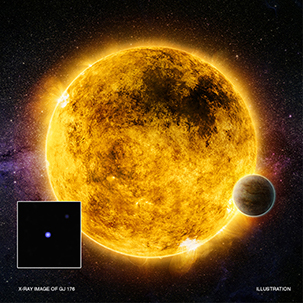Chandra Celebrates Dark Matter Day
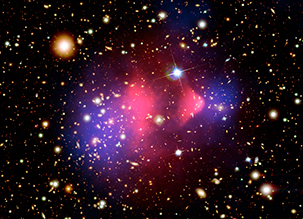
The Bullet Cluster
While October 31st is obviously known best (at least in the United States) as the day to celebrate Halloween, this year it takes on an extra meaning. Scientists and science communicators have designated October 31, 2017 to be "Dark Matter Day".
Dark matter is the mysterious and pervasive substance that constitutes most of the matter in our Universe. Although scientists have made progress in better understanding dark matter, the true nature of this invisible material remains elusive.
NASA’s Chandra X-ray Observatory plays an important role in the search to learn about dark matter. For example, in 2006 Chandra’s observations of the Bullet Cluster (officially known as 1E 0657-56) helped provide direct proof for the existence of dark matter, in a violent merger between two galaxy clusters. More recently, astronomers have used Chandra to test one model for dark matter by studying a collection of galaxy clusters.
Happy Birthday, Chandra! Google Gave You a Doodle!
Since 1998, Google has changed the logo on its homepage in honor of various holidays, anniversaries, and other events. By clicking on Google’s "Doodle", users are taken to links about that particular subject.
Chandra Makes First Detection of X-rays from a Gravitational Wave Source: Interview with Chandra Scientist Daryl Haggard
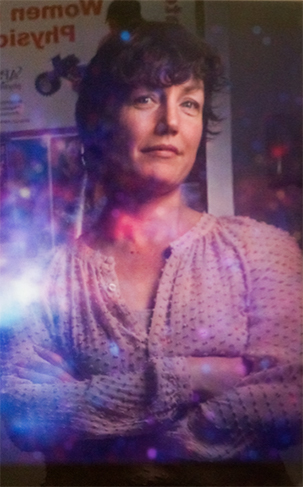
Chandra Scientist Daryl Haggard
Daryl Haggard is an Assistant Professor of Physics at McGill University. She is an observational astronomer and received her PhD at the University of Washington (Seattle, WA). She and her group study Sagittarius A*, the supermassive black hole at the heart of our Milky Way Galaxy. Haggard's team uses radio, submillimeter, near infrared, and X-ray telescopes to probe Sgr A*'s exotic environment, where strong gravity plays a key role. Her team also studies the interplay between distant growing supermassive black holes, or active galactic nuclei, and their host galaxies. And when opportunity knocks, she and her group search for X-ray flashes emitted from neutron stars and black holes when they collide. These collisions send ripples through space-time, gravitational waves, now being detected by LIGO and Virgo.
What are gravitational waves? What are neutron stars?
Gravitational waves are “jiggles” in the fabric of space-time. They are like sound waves traveling through the air around me while I talk, but gravitational waves race through the Universe at the speed of light and carry LOTS of energy away from their source.
Meanwhile, neutron stars are basically big balls of neutrons. They are born during supernova explosions when the gravity on the inside of a star is so intense it forces the electrons into the protons, making neutrons. Actually, the fusion that happens during these supernovas is how atoms like oxygen, iron, all the stuff we need for life, gets built. Neutron stars weigh two or three times the mass of our Sun, but are only the size of a modest city, like Boston or Montreal. They are incredibly dense objects. For example, if you took the Earth’s whole human population and squished it into an object the size of a sugar cube, we’d all become a neutron star.
Chandra Makes First Detection of X-rays from a Gravitational Wave Source: Interview with Chandra Scientist Wen-fai Fong

Chandra Scientist Wen-fai Fong
Originally from Rochester, NY, Wen-fai Fong received double Bachelor's degrees in Physics and Biology at the Massachusetts Institute of Technology, and earned her Ph.D. in Astronomy & Astrophysics from Harvard University. She was subsequently awarded an Einstein Postdoctoral Fellowship, which she took to the University of Arizona's Steward Observatory. She is currently a Hubble Postdoctoral Fellow at Northwestern University and will begin her appointment as Assistant Professor there in Fall 2018. Wen-fai is excited about unraveling the mysteries enshrouding cosmic explosions, including gamma-ray bursts and gravitational wave sources.
What are gravitational waves? What are neutron stars?
Gravitational waves are best described as ripples in space-time. To envision these merging compact objects, I always try to think of two round objects on a very flexible trampoline, rolling and rolling around each other. For the most flexible of trampolines, they will create some sort of pattern outward, while also spiraling toward each other and eventually colliding. It’s an oversimplified version, but that is how I best imagine what is going on.
In reality, the specific properties of the system — the masses, spins, orbital orientation, and distance — determine the very special pattern of the gravitational waves that are radiated from a system. Scientists then match that pattern against a gigantic bank of patterns by the gravitational wave experts who are able to determine very specific properties of the system. So it is a very neat and elegant problem that is made possible by many years of hard work.
Chandra Makes First Detection of X-rays from a Gravitational Wave Source: Interview with Chandra Scientist Raffaella Margutti

Chandra Scientist Raffaella Margutti
Raffaella Margutti obtained a PhD degree in Physics and Astronomy from the University of Milano Bicocca, Italy, in 2010, working on the broad-band (radio to gamma-ray) emission from relativistic jets in gamma-ray bursts within the Swift team. She then worked as a postdoctoral fellow at the Institute for Theory and Computation (ITC) at Harvard University, and then moved in 2015 for one year to New York University as James Arthur Fellow. Raffaella began a faculty position at Northwestern University (Physics and Astronomy) in 2016. She has been working in the field of Astronomical transients for more than a decade, with a wide range of expertise including, Stellar Explosions, Gamma-Ray bursts, Tidal Disruption Events, Stellar Outburst, and now, counterparts to GW.
What are gravitational waves?
Gravitational Waves are ripples in space-time that become particularly strong when very violent event in our Universe happen, like the merge of two very peculiar stars that we call neutron stars (NS). NS are what get left behind after a big star like 10 times the Sun ends its life with a big explosion.
Chandra Makes First Detection of X-rays from a Gravitational Wave Source: Interview with Chandra Scientist Eleonora Nora Troja

Chandra Scientist Eleonora Nora Troja
Eleonora Nora Troja was born and raised in Palermo, Sicily. After completing her PhD at the University of Palermo, she moved to NASA Goddard Space Flight Center as a NASA Postdoctoral Program Fellow. Her main research interest is the study of gamma-ray bursts, and in particular the connection between short duration gamma-ray bursts, neutron star mergers and gravitational waves. Beside her studies, she also leads the Swift Guest Investigator Program and serves as co-chair for the Athena mission working groups.
What are gravitational waves?
Gravitational waves are ripples in the fabric of space and time. According to Einstein’s theory of general relativity, every moving object actually emits a tiny amount of gravitational waves, but the signal is usually too small for us to detect. In order for us to detect gravitational waves, we need to wait for catastrophic events like the collision of two neutron stars. This brings to the second question, what are neutron stars? Neutron stars are some of the most exotic and dense objects in our Universe. These stars weight as much as our Sun but they are much smaller in size. A neutron star can extend up to 15-17 miles across, this is more or less the size of Washington D.C.
Seeing Double: Scientists Find Elusive Giant Black Hole Pairs
This graphic shows two of five new pairs of supermassive black holes recently identified by astronomers using a combination of data from NASA's Chandra X-ray Observatory, the Wide-Field Infrared Sky Explorer Survey (WISE), the ground-based Large Binocular Telescope in Arizona, and the Sloan Digital Sky Survey (SDSS) Mapping Nearby Galaxies at APO (MaNGA) survey. This discovery could help astronomers better understand how giant black holes grow and how they may produce the strongest gravitational wave signals in the Universe, as described in our press release.
Each pair contains two supermassive black holes weighing millions of times the mass of the Sun. These black hole couples formed when two galaxies collided and merged with each other, forcing their supermassive black holes close together. While theoretical models have predicted such giant growing black hole pairings should be relatively abundant, they have been difficult to find.
Two Stars, Three Dimensions, and Oodles of Energy
For decades, astronomers have known about irregular outbursts from the double star system V745 Sco, which is located about 25,000 light years from Earth. Astronomers were caught by surprise when previous outbursts from this system were seen in 1937 and 1989. When the system erupted on February 6, 2014, however, scientists were ready to observe the event with a suite of telescopes including NASA’s Chandra X-ray Observatory.
V745 Sco is a binary star system that consists of a red giant star and a white dwarf locked together by gravity. These two stellar objects orbit so closely around one another that the outer layers of the red giant are pulled away by the intense gravitational force of the white dwarf. This material gradually falls onto the surface of the white dwarf. Over time, enough material may accumulate on the white dwarf to trigger a colossal thermonuclear explosion, causing a dramatic brightening of the binary called a nova. Astronomers saw V745 Sco fade by a factor of a thousand in optical light over the course of about 9 days.
X-rays Reveal Temperament of Possible Planet-hosting Stars
A new study using data from NASA's Chandra X-ray Observatory and ESA's XMM-Newton suggests X-rays emitted by a planet's host star may provide critical clues to just how hospitable a star system could be. A team of researchers looked at 24 stars similar to the Sun, each at least one billion years old, and how their X-ray brightness changed over time.
Since stellar X-rays mirror magnetic activity, X-ray observations can tell astronomers about the high-energy environment around the star. In the new study the X-ray data from Chandra and XMM-Newton revealed that stars like the Sun and their less massive cousins calm down surprisingly quickly after a turbulent youth.
This artist's illustration depicts one of these comparatively calm, older Sun-like stars with a planet in orbit around it. The large dark area is a "coronal hole", a phenomenon associated with low levels of magnetic activity. The inset box shows the Chandra data of one of the observed objects, a two billion year old star called GJ 176, located 30 light years from Earth.
What Chandra & X-ray Astronomy Give Back
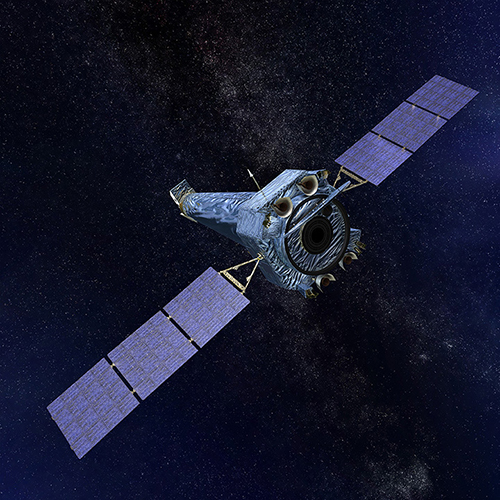
Illustration of Chandra X-ray Observatory
This week marks the 18th anniversary of Chandra’s “First Light,” when the first publicly available images from NASA’s flagship X-ray mission were released back in 1999 . Week after week, month after month, year after year, Chandra continues to deliver amazing results and make truly extraordinary discoveries across space. Scientists know so much more about the Universe now than we did before this amazing telescope began its work.


